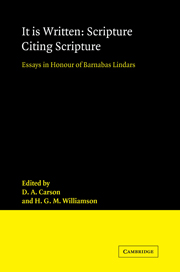Book contents
- Frontmatter
- Contents
- Preface
- Biographical note
- Abbreviations
- 1 An assessment of recent developments
- THE OLD TESTAMENT IN THE OLD TESTAMENT
- BETWEEN THE TESTAMENTS
- THE OLD TESTAMENT IN THE NEW TESTAMENT
- 11 Text form
- 12 Matthew
- 13 Mark
- 14 Luke/Acts
- 15 John and the Johannine Epistles
- 16 The Pauline literature
- 17 Hebrews
- 18 James, 1 and 2 Peter, Jude
- 19 Revelation
- Indexes
12 - Matthew
Published online by Cambridge University Press: 16 January 2010
- Frontmatter
- Contents
- Preface
- Biographical note
- Abbreviations
- 1 An assessment of recent developments
- THE OLD TESTAMENT IN THE OLD TESTAMENT
- BETWEEN THE TESTAMENTS
- THE OLD TESTAMENT IN THE NEW TESTAMENT
- 11 Text form
- 12 Matthew
- 13 Mark
- 14 Luke/Acts
- 15 John and the Johannine Epistles
- 16 The Pauline literature
- 17 Hebrews
- 18 James, 1 and 2 Peter, Jude
- 19 Revelation
- Indexes
Summary
Quotations and allusions to Old Testament passages are even more prominent in Matthew than they are in the other three gospels. Matthew's gospel includes a set of quite distinctive ‘formula’ quotations which have long intrigued scholars. These quotations are all theological ‘asides’ or comments by the evangelist. They have dominated discussion of Matthew's use of the OT and have frequently been appealed to in attempts to elucidate the origin and purpose of the gospel. In addition, there is a further important aspect of the use of the OT in Matthew which has often been neglected: the evangelist's modifications of the quotations found in his sources and the additional references he includes without using his ‘introductory formula’. The OT is woven into the warp and woof of this gospel: the evangelist uses Scripture to underline some of his most prominent and distinctive theological concerns.
Some of the unusual features of Matthew's use of the OT were observed in the early church. In his Dialogue with Trypho Justin is well aware that Matthew's interpretation of Isa. 7:14 in Matt. 1:13 is open to Jewish objections that it is based on mistranslation of the Hebrew (see chaps 77–8 which quote Matthew 1 and 2 extensively; also 67; 71; 84). In their commentaries on Matt. 27:9 Origen and Jerome both try to explain why the evangelist attributes to Jeremiah a citation which is taken from Zech. 11 : 13.
- Type
- Chapter
- Information
- It Is Written: Scripture Citing ScriptureEssays in Honour of Barnabas Lindars, SSF, pp. 205 - 219Publisher: Cambridge University PressPrint publication year: 1988

